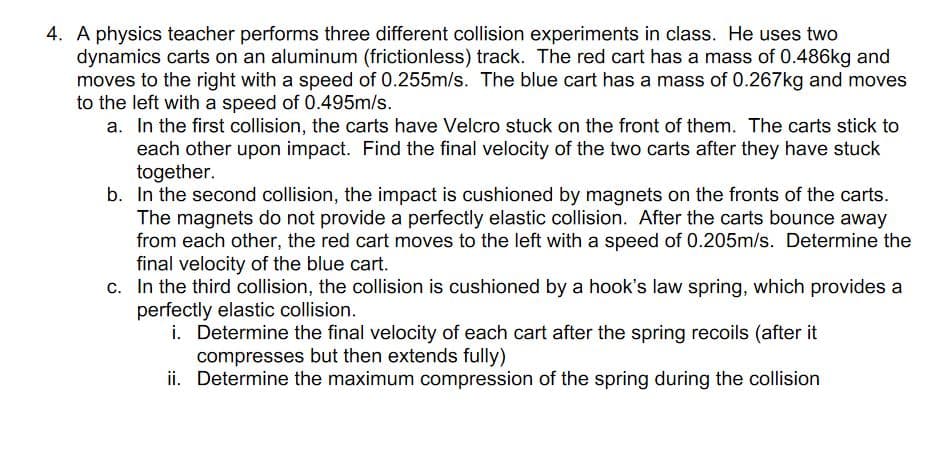A physics teacher performs three different collision experiments in class.He uses two dynamics carts on an aluminum (frictionless) track.The red cart has a mass of 0.486kg and moves to the right with a speed of 0.255m/s.The blue cart has a mass of 0.267kg and moves to the left with a speed of 0.495m/s. a.In the first collision, the carts have Velcrostuck on the front of them. The carts stick to each other upon impact.Find the final velocity of the two carts after they have stuck together. b.In the second collision, the impact is cushioned by magnets on the fronts of the carts. The magnets do not provide a perfectly elastic collision.After the carts bounce away from each other, the red cart moves to the left with a speed of 0.205m/s.Determine the final velocity of the blue cart. c.In the third collision, the collision is cushioned by a hook’s law spring, which provides a perfectly elastic collision. i.Determine the final velocity of each cartafter the spring recoils (after it compresses but then extends fully) ii.Determine the maximum compression of the spring during the collision
A physics teacher performs three different collision experiments in class.He uses two dynamics carts on an aluminum (frictionless) track.The red cart has a mass of 0.486kg and moves to the right with a speed of 0.255m/s.The blue cart has a mass of 0.267kg and moves to the left with a speed of 0.495m/s.
a.In the first collision, the carts have Velcrostuck on the front of them. The carts stick to each other upon impact.Find the final velocity of the two carts after they have stuck together.
b.In the second collision, the impact is cushioned by magnets on the fronts of the carts. The magnets do not provide a perfectly elastic collision.After the carts bounce away from each other, the red cart moves to the left with a speed of 0.205m/s.Determine the final velocity of the blue cart.
c.In the third collision, the collision is cushioned by a hook’s law spring, which provides a perfectly elastic collision.
i.Determine the final velocity of each cartafter the spring recoils (after it compresses but then extends fully)
ii.Determine the maximum compression of the spring during the collision

Trending now
This is a popular solution!
Step by step
Solved in 2 steps with 6 images









